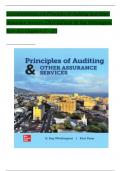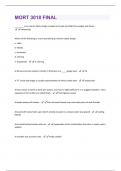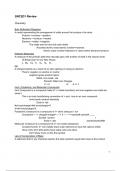SOLUTION MANUAL FOR Principles Of Auditing And Other
Assurance Services 23rd Edition By Ray Whittington
Kurt ALL Chapters (1 - 21)
, Table of Contents
Chapter 1: The Role of the Public Accountant in the AmericanEconomy
Chapter 2: Professional Standards
Chapter 3: Professional Ethics
Chapter 4: Legal Liability of CPAs
Chapter 5: Audit Evidence and Documentation
Chapter 6: Audit Planning, Understanding the Client, AssessingRisks, and Responding
Chapter 7: Internal Control
Chapter 8: Consideration of Internal Control in an InformationTechnology Environment
Chapter 9: Audit Sampling
Chapter 10: Cash and Financial Investments
Chapter 11: Accounts Receivable, Notes Receivable, andRevenue
Chapter 12: Inventories and Cost of Goods Sold
Chapter 13: Property, Plant, and Equipment: Depreciation andDepletion
Chapter 14: Accounts Payable and Other Liabilities
Chapter 15: Debt and Equity Capital
Chapter 16: Auditing Operations and Completing the Audit
Chapter 17: Auditors’ Reports
Chapter 18: Integrated Audits of Public Companies
Chapter 19: Additional Assurance Services: Historical FinancialInformation
Chapter 20: Additional Assurance Services: Other Information
Chapter 21: Internal, Operational, and Compliance Auditing
,CHAPTER 1
The Role of the
Public Accountant in the
American Economy
Review Questions
1-1 The ―crisis of credibility‖ largely arose from the number of companies that restated their
previously issued financial statements as a result of accounting irregularities and fraud. Especially
responsible werethe very visible Enron and WorldCom fraud cases. Both companies filed for
bankruptcy and constituted the largest companies in American history to do so. The extent of the
accounting irregularities and fraud being investigated and disclosed brought into question the
effectiveness of financial statement audits. In addition, the criminal conviction of Arthur Andersen,
LLP, one of the then Big 5 accounting firms, on charges of destroying documents related to the
Enron case brought into question the ethics standards of the profession.
1-2 Assurance services are professional services that enhance the quality of information, or its
context, for decision-making. The two types are: (a) those that increase the reliability of
information and (b) those that involve putting information in a form or context that facilitates
decision-making.
1-3 A financial statement audit is, by far, the most common type of attest engagement. The overall
assertion,made by management, most frequently is that the financial statements follow generally
accepted accounting principles.
1-4 A large corporation with securities listed on a stock exchange is required by the rules of the stock
exchange and by the rules of the Securities and Exchange Commission to provide an audit report
with theannual financial statements furnished to its stockholders. It also is required to engage the
auditors to provide an opinion on its internal control. Apart from legal requirements, however, a
large listed corporation recognizes that it must maintain investor confidence in the reliability of its
financial statements and internal control over financial reporting if it is to continue to be able to
secure capital from the public. The report by a firm of certified public accountants adds credibility
to the financial statements prepared by the corporation. When a small family-owned enterprise
elects to have an audit, the purpose usually is to use the auditors' report to support an application
for a bank loan.
,1-5 A report by an independent public accountant concerning the fairness of a company's financial
statementsis commonly required in the following situations:
(1) Application for a bank loan.
(2) Establishing credit for purchase of merchandise, equipment, or other assets.
(3) Reporting operating results, financial position, and cash flows to absentee owners
(stockholdersor partners).
(4) Issuance of securities by a corporation.
(5) Annual financial statements by a corporation with securities listed on a stock exchange or
tradedover the counter.
(6) Sale of an ongoing business.
(7) Termination of a partnership.
1-6 To add credibility to financial statements is to increase the likelihood that they have been prepared
following the appropriate criteria, usually generally accepted accounting principles. As such, an
increasein credibility results in financial statements that can be believed and relied upon by third
parties.
1-7 Business risk is the risk that the investment will be impaired because a company invested in is
unable tomeet its financial obligations due to economic conditions or poor management decisions.
Information risk is the risk that the information used to assess business risk is not accurate.
Auditors can directly reduce information risk, but have only limited effect on business risk.
1-8 At the beginning of the century, the principal objective of auditing was the prevention and detection
of fraud. Audit work centered on the balance sheet, because the income statement was regarded as
highly confidential and not for public disclosure. Today, the principal objective of auditing is to
form an opinion on the fairness of financial statements and their conformity with generally
accepted accounting principles. But the professional standards also require that an audit be
designed to provide reasonable assurance of detecting material misstatements, due to errors or
fraud. Particular emphasis is placed on the income statement which is of great importance to
investors. Auditing today also has the objectives ofmeeting the requirements of the Securities and
Exchange Commission (SEC) and the Public Company Accounting Oversight Board for public
companies.
1-9 The statement is incorrect. The increasing integrated databases of today, along with available
auditprocedures make audited entire populations a possibility in many situations.
1-10 An operational audit attempts to measure the effectiveness and efficiency of a specific unit of an
organization. It involves more subjective judgments than a compliance audit or an audit of
financial statements because the criteria of effectiveness and efficiency of departmental
performance are not asclearly established as are many laws and regulations or generally
accepted accounting principles.
The report prepared after completion of an operational audit is usually directed to
managementof the organization in which the audit work was done.
1-11 A compliance audit is an audit to determine whether financial reports or other assertions are in
compliance with established criteria. The necessary ingredients are verifiable data and the
existence of standards established by an authoritative body. An operational audit, on the other
hand, is a review of adepartment or other unit of a business or governmental organization to
measure the effectiveness and efficiency of operations. Internal auditors often perform
operational audits as do auditors employed by the Government Accountability Office (GAO) of
, the federal government.
1-12 Internal auditors must be independent of the department heads and other line executives whose
work theyreview. However, internal auditors are not independent in the same sense as a public
accounting firm.
, The public accounting firm serves many clients and the revenue obtained from any one client is only
a small part of the revenue of the firm. Internal auditors, on the other hand, are employees of one
company,and are subject to the restraints inherent in the employer-employee relationship. Internal
auditors can achieve a great deal of independence by reporting to the audit committee of the board
of directors, but they cannot achieve the same degree of independence as is possessed by the
external public accounting firm.
1-13 The internal auditors are employees of Spacecraft, Inc., and may be influenced by corporate management.
The public accounting firm is independent of the company and is in a better position to take
positions opposed to those of company management. The work of the internal audit staff
emphasizes measurementof the efficiency and effectiveness of various operating units of the
company and compliance with all types of controls, whereas the public accounting firm is primarily
concerned with determining the fairnessof Spacecraft's financial statements.
1-14 The Government Accountability Office (GAO) is a staff of professional auditors which reports to
Congress. Its function is to determine that programs carried out by federal agencies conform to the
financial authorization of the Congress. It is also concerned with the cost-effectiveness of
government programs. The audit activities include investigation of the costs and performance of
corporations holdinggovernment contracts.
1-15 Among the many important contributions to auditing literature by the AICPA are the series of
Statements on Auditing Standards (SASs), Statements on Standards for Attestation Engagements
(SSAEs), Industry Audit and Accounting Guides, Audit Guides, Audit Risk Alerts, Statements on
Standards for Accounting and Review Services (SSARSs), , and the Code of Professional Conduct
(only two required).
1-16 A peer review is a critical review of a public accounting firm's practices by another public
accounting firm (or other CPAs functioning as a peer review team). The purpose of a peer
review is to encourageadherence to quality control standards established by the accounting firm
and the profession.
1-17 The Securities and Exchange Commission (SEC) is an agency of the federal government and is
responsible for administering a number of acts, including the Securities Act of 1933 and the
Securities Exchange Act of 1934. In meeting this responsibility, the SEC reviews financial
statements of companies offering securities for sale to the public. It is particularly concerned with
requiring full disclosure of financial information and with preventing misrepresentation. Through
the Public Company Accounting Oversight Board, the SEC now oversees public accounting firms
that audit public companies.Included in this oversight process includes development of auditing,
independence, and quality control standards; inspection of performance; and enforcement of the
standards.
The AICPA is the national organization of certified public accountants. It has long been a
leaderin accounting and auditing research, in publication of authoritative accounting and
auditing pronouncements and studies, and in promoting high professional standards of
practice.
1-18 Services offered by public accounting firms in addition to auditing include other forms of
attestation, taxwork, consulting services, litigation support services, fraud investigation services,
personal financial planning and accounting services. This last category includes preparation of
financial statements for smaller companies that have limited accounting personnel and various
types of write-up work. Public accounting firms also perform a variety of other services.
Consulting services include aiding clients in the design of accounting systems, conversion to
,Information Technology (IT) systems, preparation of budgets, planning business combinations
with other companies, executive search, and numerous other projects. Public accounting firms are
restricted as to the consulting services that they may provide to audit clients that are public
companies.
,1-19 The partnership form of organization for a public accounting firm offers several advantages over
a soleproprietorship. A partnership offers the opportunity for specialization by the partners in
areas such as taxation, auditing, and consulting services. Partners can discuss difficult technical
problems among themselves, and benefit from different perspectives. Also, the partnership may
be better able to attract and retain high quality professional staff, because they may be rewarded
by acceptance into the partnership.
1-20 The following characteristics of a professional corporation distinguish it from the traditional corporation:
(1) All shareholders must be engaged in the practice of public accounting.
(2) To the extent possible, directors and officers should be certified public accountants.
(3) Shares of a professional corporation may be transferred only to those engaged in
publicaccounting or to the corporation itself.
(4) The corporation's shareholders and employees have liability equivalent to other forms of
organizations (i.e., the corporate form of organization does not reduce liability). Note,
however,that CPAs may choose to purchase liability insurance to limit potential liability.
1-21 Local firms usually have only one or two offices, are headed by a single CPA or have a few CPAs
as partners, and serve clients in a single city or area. The services provided are mostly income
tax work,consulting services, and accounting services. Auditing is often only a small part of the
practice.
Regional firms often arise from the merger and expansion of local firms. They typically
maintain several offices in neighboring cities and states. Auditing is a more important function for
regional firms than for the local firms, because larger businesses are included among the clients.
National firms have offices in most major cities in the United States and some operate in
other countries as well. These firms offer a full range of services, with auditing often representing
the largestsingle portion of the practice.
International firms have offices in most of the world’s major cities. These firms offer a full
rangeof services, with auditing often representing the largest single portion of the practice.
1-22 The various levels of accounting personnel in a large public accounting firm are staff auditors,
seniorauditors, managers or supervisors, and partners (and principals).
The staff auditor performs audit procedures such as the observation of physical
inventories and confirmation of receivables under the supervision of a senior. The senior auditor
plans and coordinates the audit and drafts the audit report. The senior also reviews working
papers, controls the allocation of audit time, and trains assistants on the job. The manager or
supervisor usually is responsible for supervising and reviewing several audit engagements
concurrently, and resolving significant problems with the client. The partners maintain contacts
with clients, develop new business, establish policies of the firm, review the adequacy of audit
work, and sign audit reports. The engagement partner is responsible for performance of the audit
in accordance with professional standards. A partner also devotes time to the recruitment and
development of staff, to AICPA and other professional group activities, to educational and other
civic activities, and generally to promoting an environment in which the firm can prosper. The
position of principal, which is often held by top-ranking consulting personnelwho do not hold the
CPA certificate, has responsibilities similar to those of a partner.
1-23 The most significant responsibilities of a partner in a public accounting firm include (only three required:
Assume ultimate responsibility for the audits assigned to him or her
Sign audit reports
, Review the audit work for compliance with firm and professional standards
Maintain relations with audit clients
, Establishing firm policies
Staff recruitment and development
1-24 An accounting association becomes an accounting network when member firms share one or more
of thefollowing with other member firms: (1) common brand name; (2) common control;
(3) profits;
(4) common business strategy; (5) significant professional resources; (6) common
qualitycontrol policies and procedures.
1-25 The International Auditing and Assurance Standards Board establishes International Standards
on Auditing (ISAs) International Standards on Quality Control (ISQC) and standards for other
assuranceand related services. Its pronouncements are meant to foster the development of
consistent worldwide professional standards. Its standards do not to override the national
auditing standards of its members.
Questions Requiring Analysis
1-26 (a) The Sarbanes-Oxley Act of 2002 made significant reforms in the regulation system for
public accounting firms that audit public companies. It contains provisions toughening
penalties for corporate fraud, restricting the types of consulting CPAs may perform for
audit clients, and creating the Public Company Accounting Oversight Board (PCAOB) to
oversee the accountingprofession.
(b) Primary regulation of public accounting firms that audit public companies is provided by
the PCAOB and the Securities and Exchange Commission (SEC). With respect to the
practices ofthese firms, the PCAOB has the responsibility for:
(1) Establishing or adopting auditing, quality control, and ethics standards,
(2) Registering public accounting firms,
(3) Performing inspections of the practices of registered,
(4) Conducting investigations and disciplinary proceedings of registered firms, and
(5) Sanctioning registered firms.
The SEC investigates violations of the securities laws, including allegations of fraudulent
financial reporting and public accounting firm audit deficiencies. In addition, the state
boards ofaccountancy may revoke any public accounting firm’s license to practice.
(c) Primary regulation of public accounting firms that are not under the PCAOB’s inspection
program rests with the AICPA and the state boards of accountancy. Members of the AICPA
in public practice must practice with a firm that participates in a practice review program.
Firms can meet this requirement by enrolling the AICPA Peer Review Program, which
requires the firmto have a peer review every three years. Ethical violations are investigated
and enforced by the AICPA and the state boards of accountancy.






